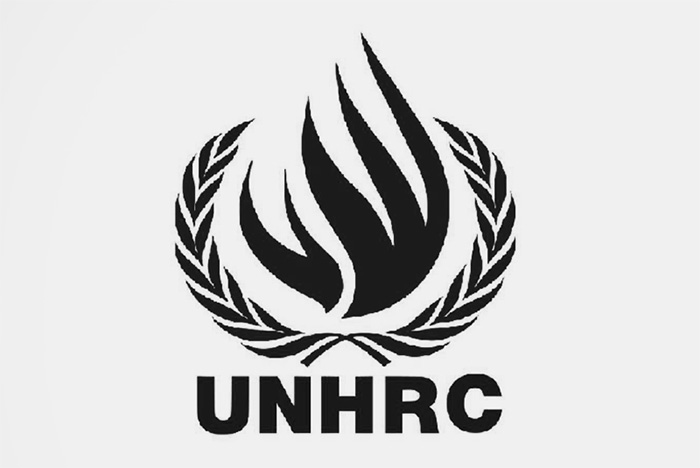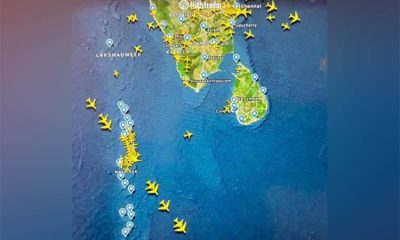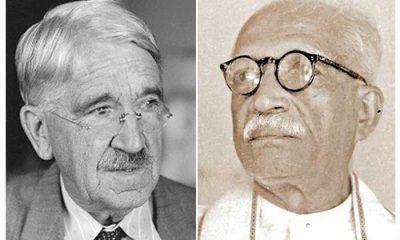Opinion
Sega Nagendra – A man of trust and humanity

Appreciation
Segarajasingham Nagendra, known as Sega, met the love of his life when they were both children. Eight years her senior, Sega was the playmate and bodyguard of his cousin Sarla Murugaser. Both were direct descendants of Sir Ponnamabalam Arunachalam, being this illustrious Ceylonese’ great-grandchildren down different lines.
As they grew up, the newly qualified driver, Sega, would give Sarla lifts home from school, borrowing his father’s Humber Hawk motorcar. She remembers him shouting at the other drivers as they cut in front, or perhaps he cut in behind. Judging Colombo’s random roadsters then as today is more a matter of opinion than fact.
Those days Sega and Sarla were just playmate cousins. Sega was schooled at St Joseph’s College, where he was an enthusiastic sportsman, while Sarla excelled as a sprinter at Ladies College. It was a few years after her leaving school that this tall skinny but extremely handsome young man was presented to Sarla as a suitor by her mother. As was often the case in those days, it was not so much the young man pursuing the young lady. Following ancient tradition, the young lady’s mother, Maheswary Murugaser, caught the young man. Having been close from a young age, neither the young man nor the young lady made any attempt to escape the chase, falling willingly into each other’s arms. For their honeymoon in 1969 Sega borrowed his father’s second motorcar, a Ford Anglia, driving the happy couple on a 1,500 km tour around Ceylon.
Sega’s parents, Dr. T. Nagendra and Annarpoorni, were content that their devoted son moved them from primary to secondary place in his affections, yielding precedence to his new bride. With his parents living close by in Rosmead Place, Sega would continue to visit them every day, possibly for the rest of their lives.
Sarla’s father T. Murugaser, a senior public servant and later businessman, who for a time managed the Sri Lanka Cricket Team, gave Sega a fatherly lecture. Sega was instructed to look after his daughter as carefully as he himself had done and to never move far away from him. Sega honoured both these promises. He treasured and cared for Sarla, as she treasured and cared for him. With her family home on Alexandra Place Colombo 7, the furthest the young couple moved was to a rented property, Rs 150 per month, on Gregory’s Road. This is on the opposite side of St. Bridget’s Convent. Not long after, they bought the property adjacent to Sarla’s parents’ in Alexandra Place. Here they lived the rest of their lives together. Here they brought up their two children, Kshirabdhi and Prashan, and welcomed their son-in-law Jekhan and their daughter-in-law Chameli. And they enjoyed their two grandsons Karnan and Suhit.
Sega commenced his career at Ford Rhodes & Thornton, later to become KPMG. After part-qualifying, Sega joined Carson Cumberbatch, one of Sri Lanka’s leading firms. Starting as a junior accounts executive earning Rs1,500 per month, he rose through the ranks in that company to become the Senior Director. As he moved into the corporate’s upper echelons, Sega became the resident general manager of Pegasus Reef, at the time a leading beach hotel.
He moved on from there to become the director in charge where Carson was the Sri Lanka agent for leading foreign products such as Michelin Tyres. He rose to become Carson’s Chief Accountant before he took on his favourite role as KLM Royal Dutch Airlines Director. His KLM role, which he held for almost 20 years, provided perks allowing him to travel extensively around the world on free first-class tickets, often taking Sarla and their two children to the USA, Europe and the Middle East. Marketing the KLM brand in Sri Lanka put him in the limelight he relished. Even though Sega himself was a teetotaler, he headed campaigns including the popular annual Oktoberfest beer festival. After he retired from Carson in 1997 Sega joined his dear friend Dion Jayasuriya to become Finance Director of CML Edwards, a company building roads and bridges across Sri Lanka. He eventually retired from CML Edwards in 2018. Until his dying day, Sega continued to be chairman and director of companies, including the technology company E-Futures where his son Prashan is CEO.
Sega was an outstanding networker aided by Sarla who was every bit his equal in this sphere. Together they made the perfect partnership, sometimes attending several dinners in a day, maintaining strong relations with friends and influencers in Colombo. Sega was a past chairman/president of the Sri Lanka chapters of the Skal Club, the Pacific Asia Travel Association, and the Chartered Management Institute. He chaired the Sri Lanka Pakistan and the Sri Lanka Benelux Business Councils. In 2015 he became Chairman of perhaps Sri Lanka’s most prestigious association, The Colombo Club.
Every human enjoys happiness and suffers tragedy. Sega was a leading businessman, director and chairman of many companies, patron and trustee of temples and associations. He was highly respected as an honourable man who would do his utmost to see fair play. His relationship with his wife was one of the best I have ever seen. However, his greatest tragedy was losing his daughter, who suffered from pulmonary fibrosis and passed away in London in 2013 at 40 years of age, leaving her 16-year-old son and husband. For the remaining nine years of his life, this tragedy remained with him. He was her hero, she was his angel.
At Sega’s funeral, I was told by many what I already knew. That he
was a very good man. That he was a people’s person. I can personally attest he would greet the office peon as sincerely and kindly as he would an ambassador.
Sega passed away suddenly of a heart attack. He and Sarla had recently spent Christmas in England, visiting his grandson Karnan and fiancée Ellie at their new home in Folkestone. Just a month before they had visited me in Jaffna, the town of their ancestors. Sega had the good fortune to make these important reconnections before he was taken.
The world lost one of its gentlemen. I believe, by his example, others who knew him have learned to become gentlemen and gentlewomen.
JEKHAN ARULIAH
Son-in-law
Opinion
Towards a more profitable and sustainable agriculture

BY Upatissa Pethiyagoda
One of the key happenings in human history, is the so-called “Industrial Revolution,” that originated about two centuries ago, with Europe, North America and Japan, as the focal points. These are now broadly defined as “Developed Countries.” They distinguish themselves as having higher per capita incomes, and thereby offering their citizens better living conditions than do the ‘developing’ or ‘less developed’ ones.
It is tempting yet erroneous, to believe that what prevailed two centuries ago, can be transposed today to other countries including Sri Lanka, presently classified among the “Developing countries.”
Typically, the industrial era manifested as a movement away from labour and towards machinery driven enterprises. The unspoken assumption is that what worked for them then, should do for us now.
This is a presumption that is unlikely to happen. Although a small Tropical country within the Monsoon belt, we are fortunate in being generally spared weather-related atmospheric perturbations such as hurricanes, cyclones and tsunamis, which assail other similar sized countries and locations.
Overall, we are also fortunately blessed with largely favourable climatic conditions and reasonably fertile soils, to ably support a sustainable, diversified and a seemingly unique mosaic of farming, livestock and forestry. This is worthy of protection.
By virtue of our geography, climate, tradition and aptitude, we are well positioned to be a dominant base for a vibrant Agrarian Economy. A composite of the sectors associated with plants and animals, best suits our natural strengths. This leads us logically to seek economic advancement through this sector, with a blend of farming, livestock and forestry, to best support environmental stability as our long-term goal.
Two factors that are poised to impact on Worldwide agriculture, are “global warming” and a looming “water crisis.” These will affect different regions with differing severity. These possible hazards have aroused much International concern. Sri Lanka would do well to prepare itself for these eventualities.
In the particular context of Sri Lanka, the major concerns would lie in the agrarian, forestry, fishery and environmental sectors. The focus for close and timely attention include the following:
(i) Correcting weaknesses in the Extension Services which are primarily blamed for under- performance. All officers concerned in the above sectors, would benefit from periodic exposure to training that is designed for upgrading knowledge and sharpening requisite skills.
(ii) The Sri Lankan Agricultural Sector divides itself into two components, namely, the Export and Local Crop sectors. Animal farming is set apart, and historically has received less attention. However, the recently expanding poultry industry has resulted in greater attention to livestock expansion.
(iii) In Ceylon’s colonial history, it was the British who eventually exercised their sovereignty over the whole country, succeeding the Portuguese and Dutch, who were confined to the coastal regions. Cinnamon was the first crop that attracted the colonisers, followed sequentially by Cinchona (Pyrethrum, on a small scale) and Coffee. In the 1840s, the invasion by the Coffee Rust (Hemileia vastatrix), laid waste to the Coffee plantations. Tea took over and rapidly expanded, mainly by encroaching into Highland Forest areas. Little attention was given to environmental and social consequences. Meanwhile, rubber plantations dominated in the wetter Lowlands. A while later, attention was directed towards Coconut.
(iv) Research Institutes – TRI, RRI and CRI were established to cater to the needs of the fast developing Plantation Crops.
The introduction of Plantation Crops had far-reaching and lasting Economic, Political, Social, Environmental and Cultural consequences. The more recently established Minor Export Crops, (renamed as The Export Crops Sector) mainly services the Spice Crops – Cinnamon, Pepper, Nutmeg and Cardamom. Also Cocoa and Coffee. Sugar, Cashew and Palmyrah are crops that are developing their own support structures.
(v) All others are catered for by the Department of Agriculture, whose main efforts are understandably focused on the Paddy sector. This is a sector that had received scant attention from the colonial British, who had an understandable preference for importation of rice from their colonial Burma and Thailand.
(vi) The cleavage (into export and local sectors), while having several operational advantages, also created problems. Seriously, the result is an inequality in resources (most notably in the matter of qualified staff) and consequent waste.
A major problem in consolidation and improving the services of research and extension arises from differences in the sources of funding. The TRI is funded entirely by a cess on exports, while the Departments of Agriculture and Minor Export Crops are dependent entirely on the government, and the RRI and the CRI by a mix. This has resulted in big differences in staff strengths and organisational complications. There are thus an under-utilisation of staff, facilities and distorted priorities.
(vii) The tea industry in its early expansive phase, relied heavily on indentured labour from South India. This coupled with the unjust expropriation of lands belonging to locals, particularly those of the Kandyan peasantry, and the ecological damage by unrestricted invasion into forest areas in the central hills, has created seething resentment and ecological harm. The massive importation of South Indian labour, particularly in the expansion phase of the tea industry, have resulted in social, economic and political complexities prevailing even now. This is still a silent concern.
(viii) Since it is impossible to balance the requirements and production of agricultural produce, scarcities and gluts are not uncommon. Scarcities are met by imports, while surpluses largely result in waste. This can be as high as 35% in the case of perishable vegetables and fruits.
This is a colossal loss. It is scarcely possible to point to a single agronomic practice that can provide a similar return. Thus, if such losses can be limited or eliminated, the impact will be considerably greater than any improvement in agronomic practice. This must be a binding pre-requisite for a sustainable agriculture. Quality improvement begins with timely harvesting, minimising bruising, exposure to light and heat, packaging and transport. Models are available for delicate or vulnerable products (e. g. Bananas and Cut Flowers) that could offer hints of what procedures and facilities such as “Cold Chains” are necessary or feasible.
(ix) To deal with product surpluses, obvious remedies include providing better storage facilities with protection from insects, fungi, rodents and other marauders. Such storage could suit Paddy, maize, pulses, peanuts and some fruits. In the case of vegetables, many fruits and other perishable produce, post-harvest handling and transport are key needs. Where appropriate, preservation by simply drying (by Sun, ovens or other equipment), freezing, canning, bottling and packaging are means of coping with surpluses and in most cases, also as a means of value addition.
These are the considerations paramount in developing a profitable and sustainable Agriculture – which will continue to play a key role in the National Economy. The focus should change to an Agriculture prioritizing Food Security, import substitution and improvements of farmer livelihoods.
(x) Land Use. Hitherto, the agricultural services have been “crop based”, largely for historical reasons. By far, a change to an emphasis on a “Land use” paradigm, would be logically, economically and environmentally more sound. Despite the inconvenient financing and logistics issues, on balance, the benefits in the long term will decidedly outweigh the initial effort.
(xi) Agricultural Shows offer great opportunities to track and procure genetically superior cultivars for multiplication. This will play a vital role. Technologies evolved in Home Garden and Plant House efforts are obvious sources of new knowledge and practices.
(xii) A persistent problem in Colonization Schemes is to retain, support sustainable cropping patterns, capable of sustainable livelihoods. The common tool is to provide Model Units to combine crop, livestock, pastures, and Forestry, with choices and production designs and “mock-ups” for different sizes of land allocations.
(xiii) “Going organic” is certainly much superior in maintaining soil fertility, reducing erosion, and supporting more favorable conditions for maintaining the soil biome (bacteria and earthworms), mitigating ill effects of continuous reliance on chemicals for nutrient needs, weed-killers and pesticides. A soil devoid of its natural diversity is effectively dead and in its sterility becomes a mere unsustainable anchoring medium.
(xiv) In our particular case, there is an alarming decline in fertility and increase in soil erosion, resulting from heavy and long term application of artificial fertilizers (especially ammonium sulphate for tea). A total and objective and unbiased intervention, to examine the costs (including maintenance and “opportunity cost”) and returns. This may result in surprising revelations but need not deter a re-evaluation.
Opinion
UNHRC faux pas: BRICS yet another!

Tamara Kunanayakam deserves the gratitude of all Sri Lankans concerned by the machinations of US and its allies, for the excellent commentary titled “UNHRC resolution, good governance, BRICS – Operation camouflage?” (The Island, 11 November). She is an experienced diplomat and was the Permanent Representative of Sri Lanka to the United Nations Office at Geneva from 2011. She successfully defended Sri Lanka at UNHRC when the process of passing resolutions against Sri Lanka started.
While the odd behaviour of the government regarding BRICS, which she had gone into detail in her piece, was very much in the news, what she stated about the UNHRC resolution focuses on the intentions as well as capabilities of the JVP/NPP government. This coming from a person with intimate knowledge of the workings of the UNHRC, gives added weight.
Vijitha Herath, the government spokesman’s declaration that the UNHRC resolution drafted by USA/UK and presented to the council by the UK was ‘strongly rejected’ by the government got wide coverage in the media. However, what followed was hardly mentioned and I was surprised and taken aback by the following paragraphs in her commentary:
“Nevertheless, on that same day, the resolution that the Government had “strongly” rejected was adopted without a vote, i.e., by consensus, and consensus resolutions necessarily involve the explicit or implicit consent of the country concerned.
Had indeed the Government “rejected” the external mechanism, it would have called for a recorded vote, the only way to prevent consensus on a hostile draft. Being a non-member state, it would have had to request a friendly country to act on its behalf, and Cuba, China and Pakistan have always obliged. Without a specific request from Sri Lanka, no country that respects the principle of state sovereignty and the right of peoples to self-determination would have called for a vote. It is evident that that request never came. By the decision not to call for a vote, the Government did the opposite of what it had said it would do, even reversing Sri Lanka’s previous rejection of the mechanism at the Council’s 2021and 2022, and consenting to its establishment as well as extension.”
This action of the government raises very significant issues. Was this lapse, if indeed it was, due to inexperience? Or, has the faux pas exposed the sheer incompetence of this government? Worse still, is this government also run by a Viceroy?
Perhaps, as she alludes to, it is an ‘operation camouflage’
Dr Upul Wijayawardhana
Opinion
Valuation Department – a sick giant in deep slumber

Seventy-nine months – six years and seven months – for a file to be cleared by the slack officers in the Valuation Department. Finally, after much effort, in June 2023, a lady officer was cajoled to look into it. The file that was in hiding was retrieved from some deep dungeon and a clerk was directed to work on it. In July 2023, the completed file was sent to the Divisional Secretariat, Kotte. The formal valuation was sent to me – and I detected a serious error in the valuation as the extent of my land given in the document was totally erroneous. Surveyor General official document following surveying the land in 2017, has certified my ownership as 0.0337 HECTARES.
(1 HECTARE IS EQUAL TO 395.3686 PERCHES)
On this basis, the extent of my block of land is 13.3239 PERCHES.
This is the only block of land I own. It is situated off Temple Road in the vicinity of the Open University. I was notified that it had been earmarked for acquisition for Flood Control Project Development purposes by the SLRDC. For the valuation that has to precede the granting of compensation for my land, I had to go through formalities such as repeatedly surveying the land, obtaining legal documents to prove my ownership and several other documents and information connected with it. These procedures have cost me a large sum of money as well as time and hard work. After several months of tedious labour running from pillar to post, SLRDC was satisfied that the requirements are in order.
SLRDC SENT DOCUMENTS TO VALUATION DEPARTMENT IN 2018
Thereafter, the documents were sent from SLRDC to the Valuation Department on January 2nd 2018—more than 6 years ago. The file has been lying on the desk of an officer through all these months. When inquiries were made in 2020 from time to time the officer dealing with my file was habitually late for work, not in her seat, absent for days due to illnesses like ear ache, etc. These were the frivolous excuses given for not attending to my file. She is currently transferred to an office in Maharagama.
Three reminders were sent by SLRDC to Valuation Department to expedite the valuation. Yet, the reminders were totally ignored.
Valuation Department after a very long period of 79 months, has woken up and has sent a valuation that shows the extent as 0.0337 PERCHES with a value stated as Rs.100,000 for the entire extent of 13.3239 Perches. This valuation is totally erroneous and quite suspicious as there seems to be a sinister move to put me off the track and carry out some underhand dealing. Where would anyone get even ONE perch of valuable land in Nawala for that amount?
This is a fraudulent valuation. My file was kept in hiding for over 6.5 years from 02 January 2018 to July 2023. I have been constantly trying to make the Valuation Department work on it – writing to them numerous letters, appeals and personally trying to meet the relevant officers but to no avail. I sent a formal complaint to the Chief Valuer. Never did I receive a response. This is the extremely slack, careless and inefficient manner in which the officers of the Valuation Department discharge their duties. This Department that handles money worth millions needs to be fully overhauled and the entire officers from top to bottom need a thorough cleansing. It is a hell hole of corruption.
I am writing this with great pain of mind and utter disappointment regarding the unexplained huge delay and final careless and fraudulent valuation that is being awarded to me. I am certainly not prepared to accept this minuscule award.
I was also notified that in the event that I do not accept the decision, I could appeal to a Reviews Board. I sent my appeal promptly under registered cover to the Reviewing Board in September 2023. In my appeal I stated that nowhere in the vicinity of Nawala so close to the Open University and other strategic places could one buy even one perch of land for Rs.100,000. This undervaluation shows some hidden agenda which I am certain of. The extent shown on the official valuation is incorrect. It is NOT .0337 Perches BUT .0337 HECTARES.
There are houses alongside mine and professionals residing in the adjoining blocks; this being a highly residential area in the heart of the city. My land has some trees and vegetation. At some moment in time, former president Gotabaya Rajapaksa had in a high-handed manner and without my knowledge or approval dug a trench across my land and another block bordering mine.
Since my appeal to the Reviewing Board, one year has also gone by and the appeals officer also is in deep slumber. I called a few times to see if the matter is being attended to and was vaguely told that they have sent it to SLRDC, Kotte for some further information. When I contacted SLRDC, I was told that the information had been sent promptly. Appeals section lady officer gave vague answers when called again. She is still silent. One does not know who is lying. These are state officials entrusted with providing responsible service to people. The Valuation Department hung onto my file for over 79 months (six and a half and more years) with absolutely nothing being done and now finally a blatant error in extent of the land.
Seventy-nine months is an awful lot of time to deal with many matters that are important to my life. I am sure that these comments of mine are shared by many others whose files are stagnating at the Valuation Department due to the negligence and lackadaisical attitude of the officers from the highest to the lowest in that department.
President Anura Kumara Dissanayake has an Augean task to clean up these filthy, foul- smelling stables, shake the sleeping officers from their deep slumber and get them to work as they should. Replies to letters, correspondence from the public have to be answered promptly is another duty these officers are bound to carry out. In this era of technology, emails could do the job.
When one surfs the website, there are many officers with high-flown credentials but sadly they do not seem to have control over those who hide files for whatever undisclosed reason. Over to the Chief and others in authority at the top to solve this problem of mine as I am at the mercy of slack and careless officers at the Valuation Department. In concluding, I wish to say that valuation means numbers and the officers need to be given basic lessons in Arithmetic, land and area extent conversion tables. They cannot and must not make glaring mistakes in cases such as mine.
M. P. Warusawithana
empeew@gmail.com
-

 News5 days ago
News5 days agoHarin drags Messi into poll mess
-

 Features4 days ago
Features4 days agoAdani’s ‘Power’ in Sri Lanka
-

 Opinion6 days ago
Opinion6 days agoSri Lanka’s missed opportunities
-

 Features5 days ago
Features5 days agoEducation, democracy and unravelling liberal order
-

 Editorial5 days ago
Editorial5 days ago‘Political prisoners’
-

 Latest News2 days ago
Latest News2 days agoColombo district preferential votes announced
-

 Opinion5 days ago
Opinion5 days agoAre cracks already showing ?
-

 Editorial6 days ago
Editorial6 days agoCorpse-driven politics











